Kusatsu Onsen, located in Kusatsu Town, Agatsuma District, Gunma Prefecture, is one of Japan’s most famous hot spring resorts, boasting an abundant supply of hot spring water. It has been cherished by many people since ancient times. Here, we will introduce the charm and tourist information of Kusatsu Onsen.
There are various theories regarding the term “Japan’s Three Great Hot Springs.” Originally known as “Japan’s Three Famous Hot Springs” or “Japan’s Three Ancient Hot Springs,” the terminology has changed over time, and each designation actually refers to different hot springs. Incidentally, Kusatsu Onsen is considered one of Japan’s Three Famous Hot Springs.
Japan’s Three Great Hot Springs are
- Arima Onsen(Hyogo)
- Kusatsu Onsen(Gunma)
- Gero Onsen(Gifu)
loves hot spring
is interested in Kusatsu Onsen
wants to know about sightseeing information in and around Kusatsu Onsen
Attractions of Kusatsu Onsen
In my personal opinion, Kusatsu Onsen has three main charms.
- Abundant Hot Spring Water
Kusatsu Onsen boasts one of the largest volumes of hot spring water in Japan, with approximately 40,000 tons of water gushing out each day. The hot spring water is a sulfur spring, known for its health benefits and therapeutic effects. - A Historic Hot Spring Town
With a history spanning over 1,300 years, Kusatsu Onsen is a beloved hot spring town that has attracted people for centuries. The town is lined with historic buildings and traditional souvenir shops, allowing visitors to immerse themselves in history and culture. - A Hot Spring Resort Surrounded by Beautiful Nature
Kusatsu Onsen is nestled in a natural environment that showcases breathtaking scenery throughout the year. In spring, cherry blossoms bloom; in summer, lush greenery abounds; in autumn, vibrant foliage paints the landscape; and in winter, snow blankets the area. Visitors can enjoy a different atmosphere in each season.
Although I tend to associate hot springs with winter, Kusatsu Onsen can be enjoyed throughout the year—spring, summer, autumn, and winter alike.

How to access to Kusatsu Onsen
You can reach Kusatsu Onsen by public transportation or car.
By Train
If you take the train, transfer to a bus from JR Kusatsu Station or JR Shibukawa Station, and you will arrive at Kusatsu Onsen in about 20 minutes.
By Car
If you are driving, take the Kan-Etsu Expressway and exit at Shibukawa Ikaho IC. Then follow National Route 353, and you will reach Kusatsu Onsen in about 30 minutes.
By Bus from Tokyo
Since I traveled from Tokyo, I took a direct bus departing from there. You can make a reservation via the official website. The one-way fare is 3,500 yen, and the journey takes about 4 hours and 40 minutes, including one rest stop.
Sightseeing spot in Kusastu Onsen
Here are some must-visit spots and recommended places to eat when you come to Kusatsu Onsen!
Must-Visit Spots
- Netsu-no-Yu Yumomi Performance
- Yubatake (Hot Water Field)
- Osayu-Yu
- Kusatsu Onsen Tegata (Hot Spring Pass)
- Light-Up
Netsu-no-Yu Yumomi Performance
Kusatsu Onsen’s famous Yumomi Show is incredibly popular, often drawing long lines, especially on weekends. Tickets can only be purchased on the day of the performance, right before the show starts, so if you want to attend, it’s best to line up early. The first show of the day begins at 9:30 AM, and occasionally, you can even experience the Yumomi activity yourself. For more details, be sure to check the official website.
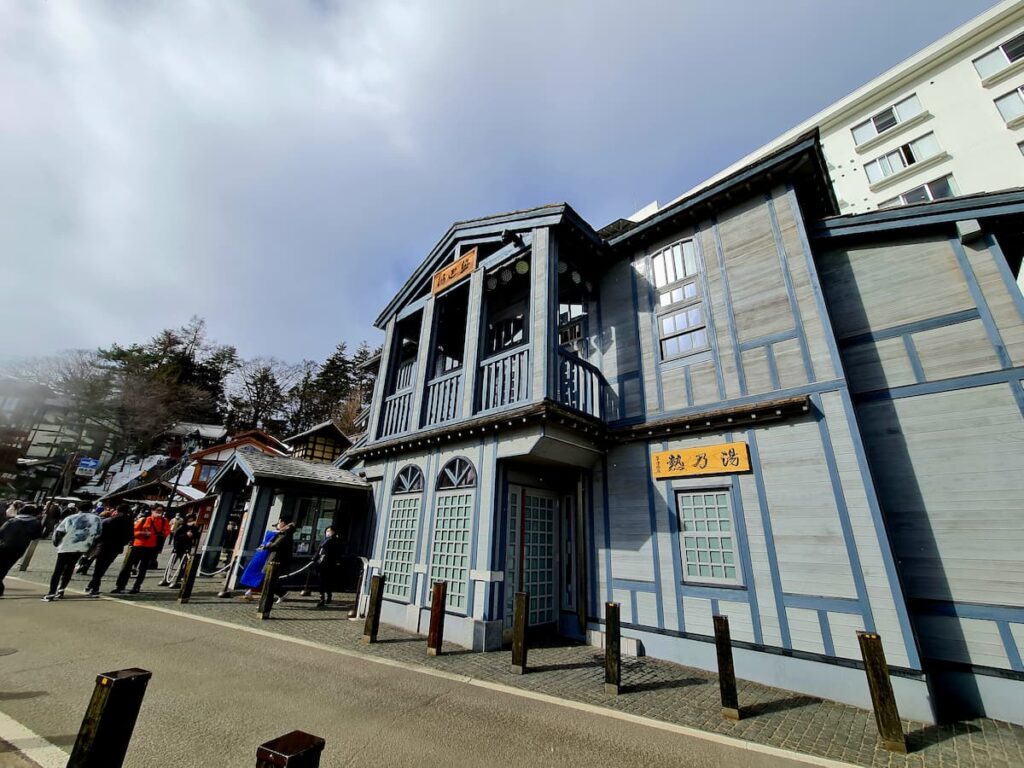
The fee is 700 yen per adult and 350 yen per child, half the price. The performance consists of a video on the history of Kusatsu Onsen, dancing, and two hot spring baths, and it lasts less than 20 minutes.
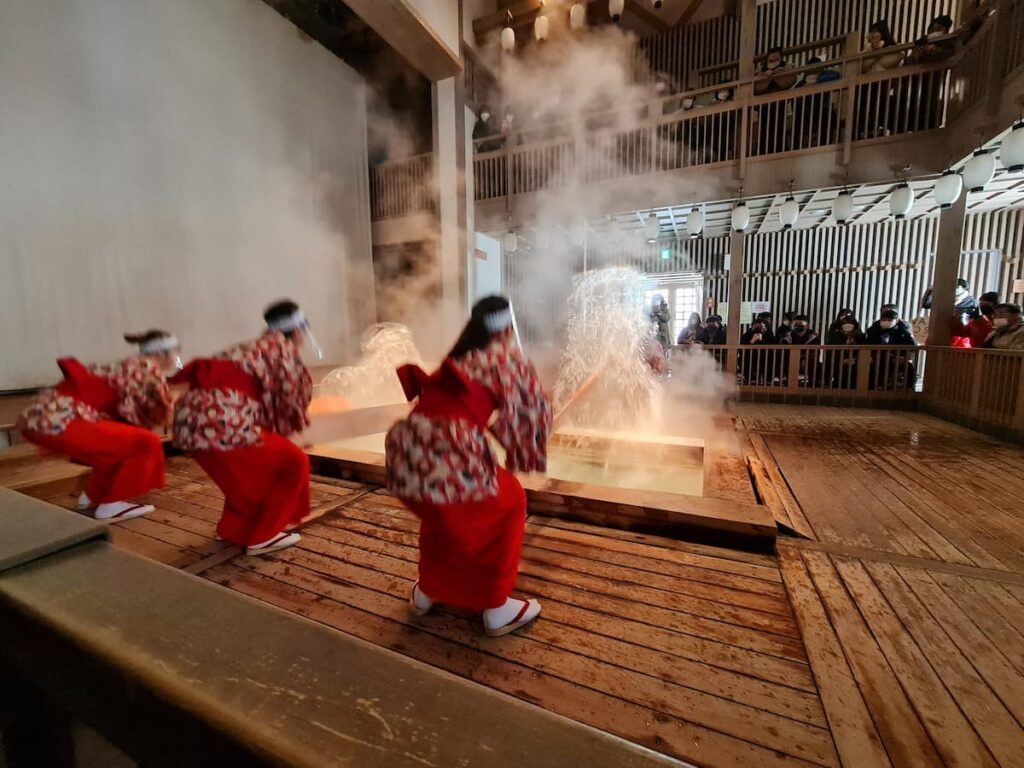
The second hot water fir is an aggressive hot water fir and performs a performace that makes the hot water jump up high.
Yubatake (Hot Water Field)
This is the first place you will see when you come to the hot spring resort area of Kusatsu Onsen. It is the symbol of Kusatsu Onsen.
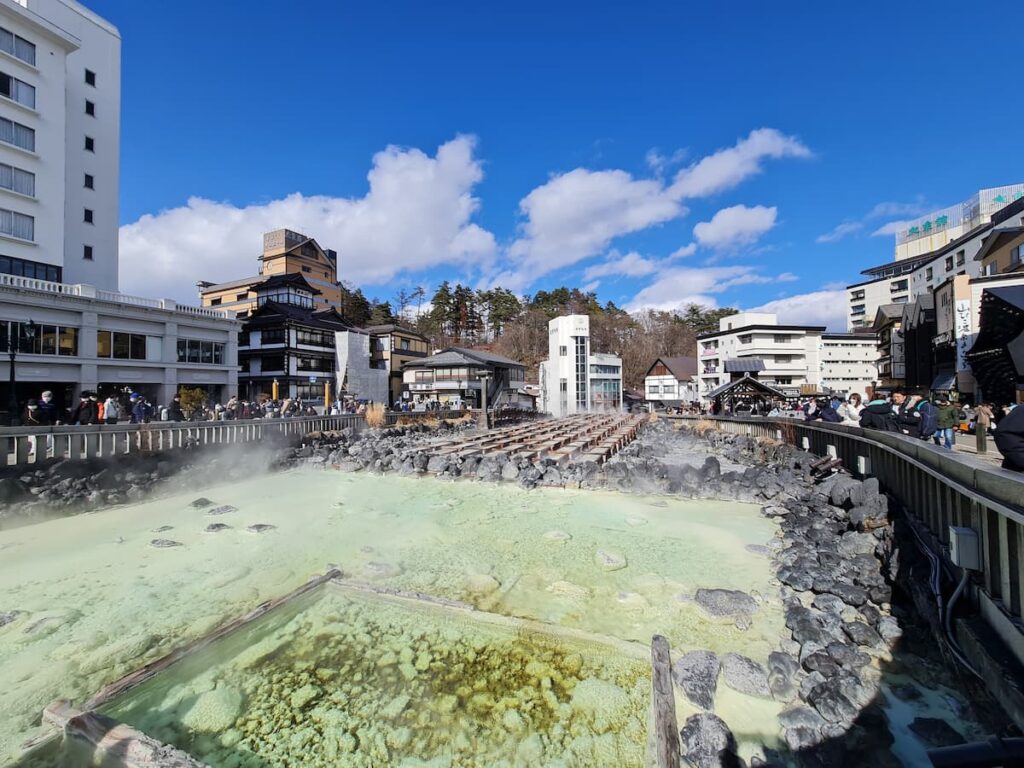
Kusatsu Onsen boasts the highest natural hot spring flow rate in Japan, with over 40,000 liters of water gushing out per minute. This is why many of the ryokan (traditional inns) and hot spring facilities in Kusatsu can offer “gensei kakenagashi” (direct flow of the spring water). Be sure to fully enjoy the “source spring” and its benefits.
In winter, the area is beautifully illuminated, creating a magical atmosphere with a view that’s completely different from the daytime, with steam rising from the hot springs adding to the charm.
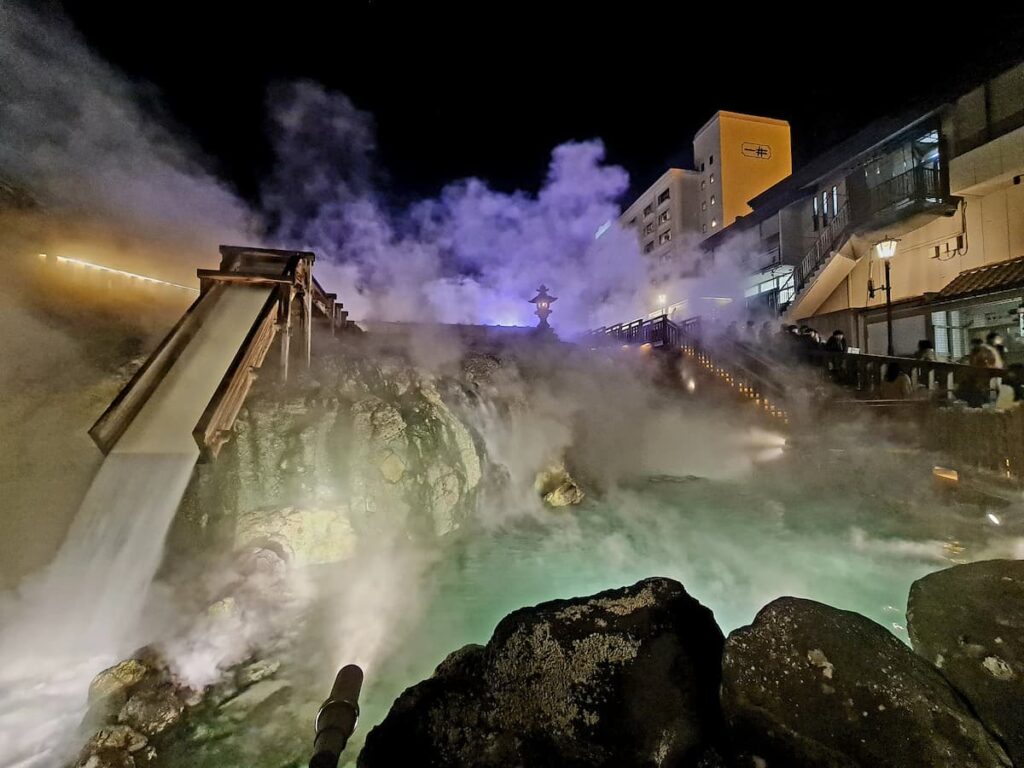
Osayu-yu
There’s a monkey version of the famous Yumomi performance. Two monkeys put on a show, demonstrating their skills and performing the traditional Yumomi technique.
As the name suggests, these monkeys entertain visitors with various tricks while also demonstrating the Yumomi process, making it a heartwarming and unique form of entertainment.
On the second floor, there is an animal interaction area and a capybara hot spring. The entrance fee for the second floor is 500 yen, and the Osayu-Yu Show is 600 yen.
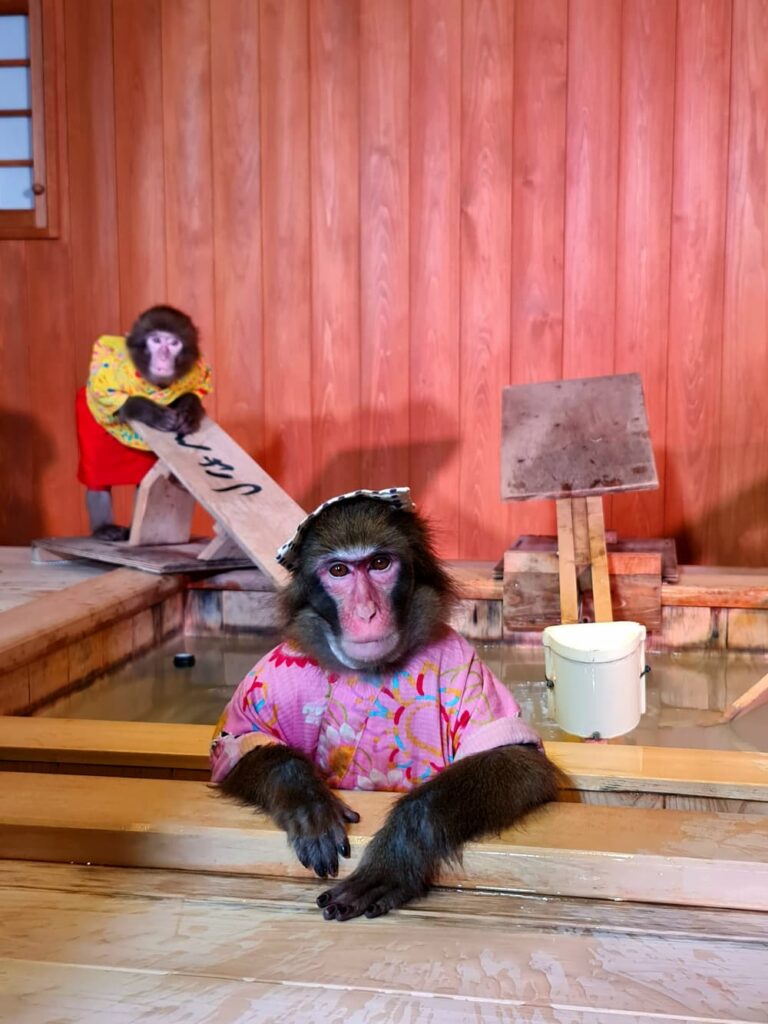
Kusatsu Onsen Tegata (Hot Spring Pass)
This is a special hot spring bill that allows you to enter the following three hot springs.
- Goza-no-yu
- Otaki-no-yu
- Nishi-no-Kawara Onsen
Normally, the entrance fee for each hot spring is 2,380 yen for adults, but by purchasing the Tegata (Hot Spring Pass), you can enter for only 1,800 yen. The pass is given in the form of a postcard, which also makes for a great souvenir. Even better, the pass has no expiration date, so you can carry it over to your next visit.
You will need to bring your own bath towel, but if necessary, you can purchase one at each hot spring along with the pass.
As for the hot springs themselves, let’s start with Goza-no-Yu.
Goza-no-yu
Kusatsu Onsen has been loved by many people for over a thousand years. Goza-no-yu” is located right in front of Yubatake, the symbol of Kusatsu Onsen, and has been reproduced in Yubatake.
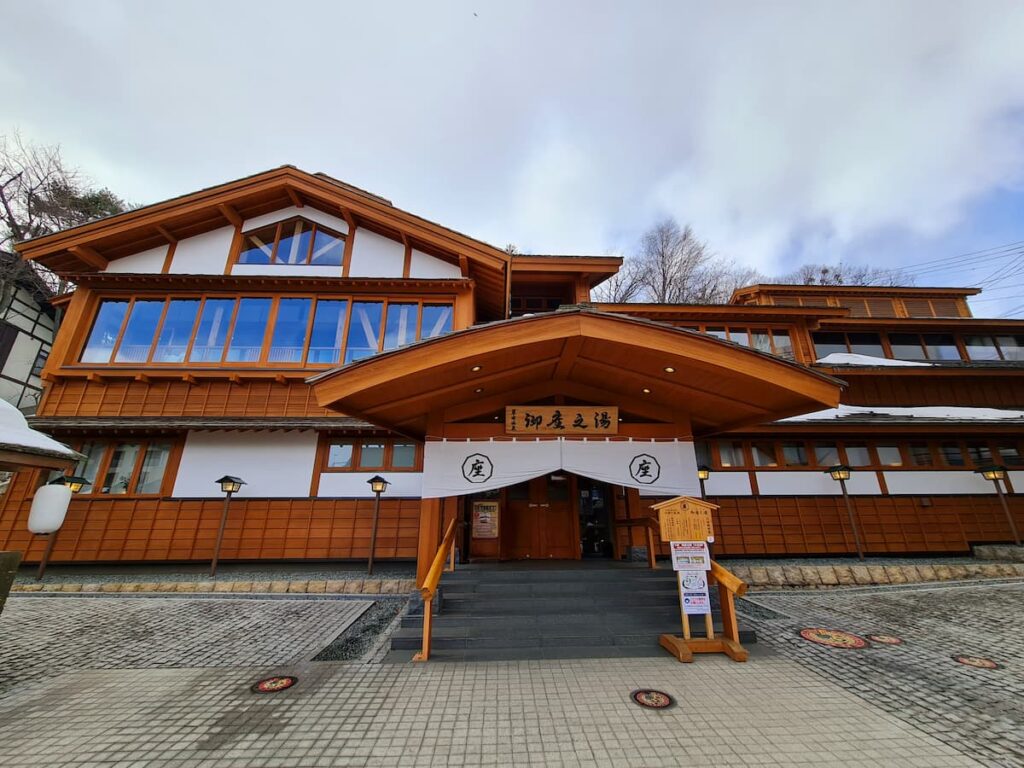
Goza-no-Yu has two bathing areas: Kino-yu (Wooden Bath) and Ishi-no-yu (Stone Bath), with the gender of each bath alternating daily. Each bathing area uses two different sources of hot spring water: Yubatake (Hot Water Field) and Bandai. If possible, try both baths to fully enjoy the different experiences each source offers!
Otaki-no-yu
Among the many hot springs in Kusatsu Onsen, Otakino-Yu uses the renowned Nikawa Gensen, known as the “Beauty Hot Spring” for its skin-benefiting properties. It’s famous for its ability to leave the skin feeling smooth and rejuvenated, making it a must-try for those looking for a relaxing and beautifying experience.
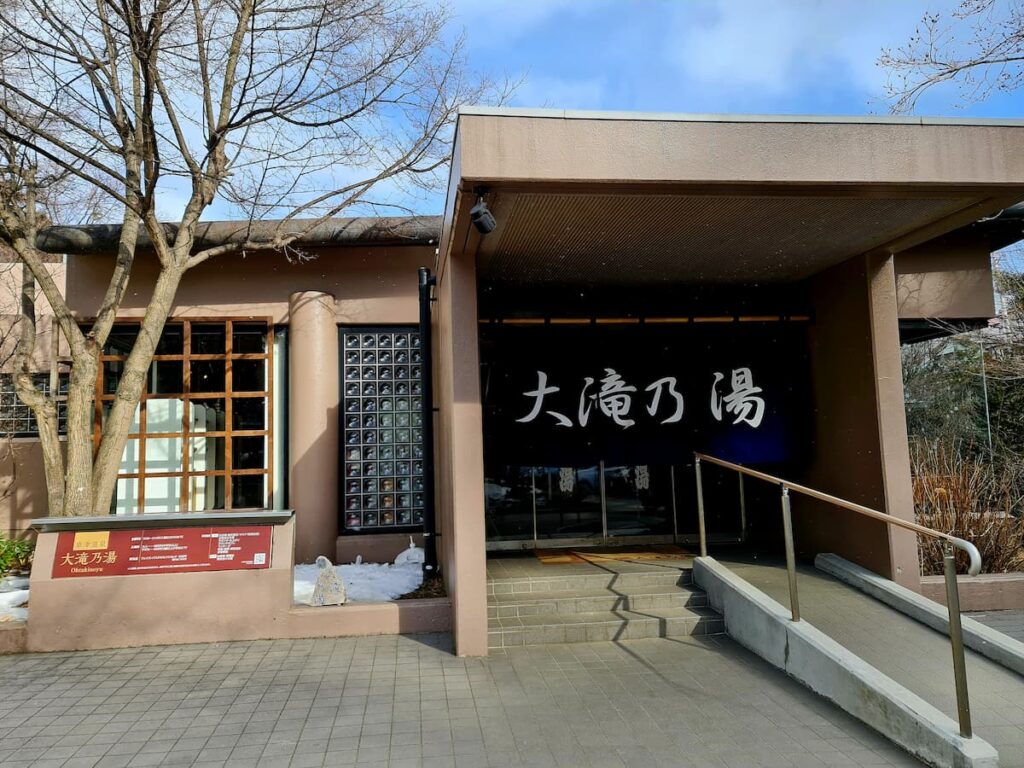
One of the unique features that Otakino-Yu offers, which is not commonly found in other ryokan (traditional inns), is the Awaset-yu (combined bath).
Awaset-yu is a traditional Kusatsu practice that has been passed down for generations. In this bath, the hot spring water naturally circulates through multiple tubs without being diluted by water, gradually cooling to a comfortable temperature. The tubs are arranged in order of increasing temperature, so it’s recommended to start with the cooler bath and slowly adjust your body to the increasing heat.
There are four different hot springs in this setup, but the fourth bath is so hot that I could only stay in it for about one minute.
Nishi-no-Kawara Onsen
The name Nishi-no-Kawara Onsen comes from its location on the western side of Kusatsu Onsen. From various spots along the riverbank, 1,400 liters of hot spring water gushes out every minute, forming a natural hot spring stream.
The path to the outdoor baths is also filled with sights to see, such as Anamori Inari Shrine and the Fudo Waterfall. Along the way, you’ll find many spots where you can enjoy a free foot bath (just be careful of the water temperature!). It’s a wonderful place to relax and enjoy the natural surroundings while soaking your feet in the healing waters.
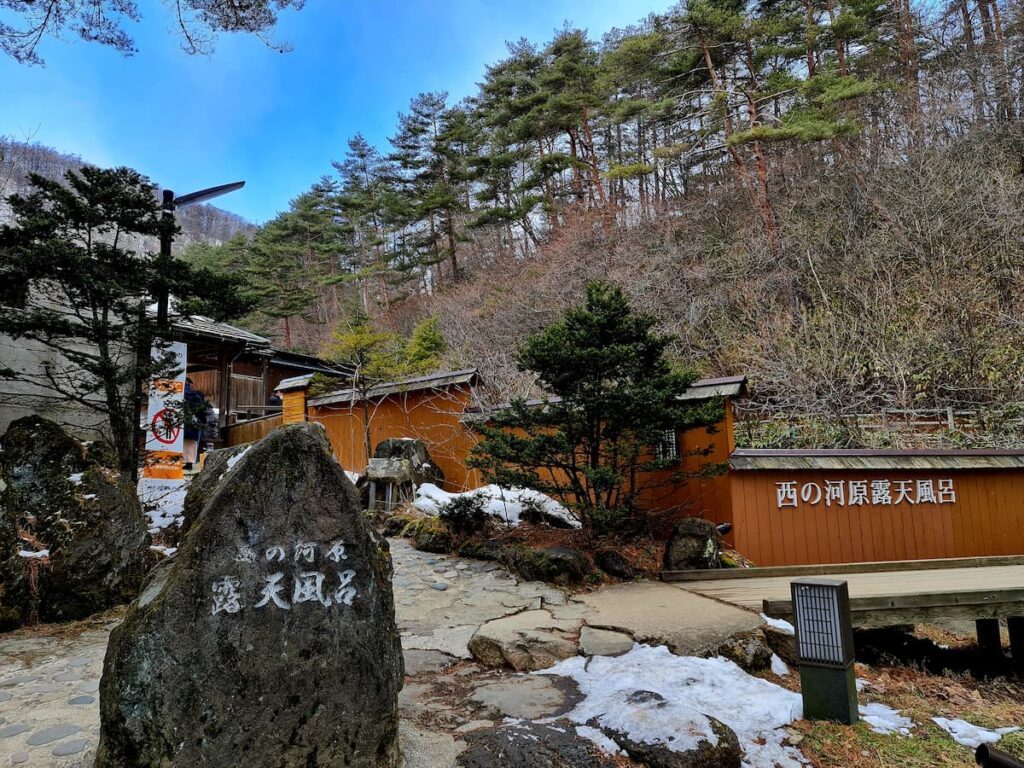
Both men’s and women’s baths are open-air baths, but on Fridays they may be mixed.
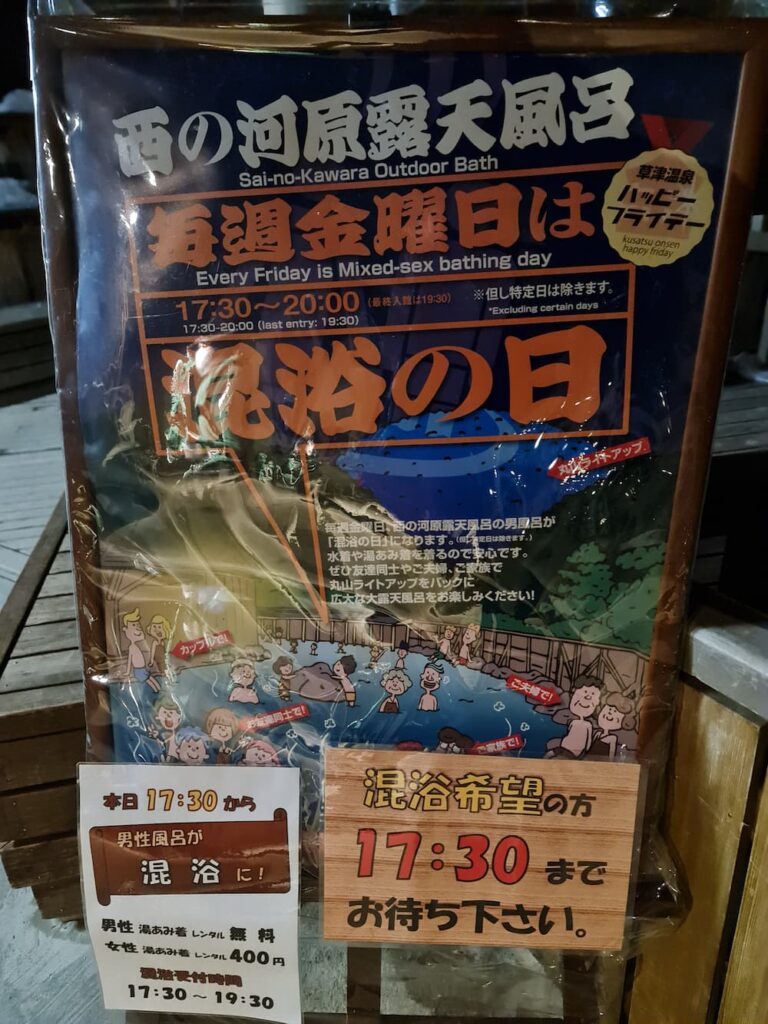
Light-Up
The light-up is a seasonal event, available only during the winter period, from mid-November to mid-February. It’s one of the highlights of Kusatsu Onsen in winter.
Two places where you can enjoy the light-up are:
- Yubatake (Hot Water Field) – The iconic symbol of Kusatsu Onsen, beautifully illuminated at night.
- Nishi-no-Kawara Onsen – The outdoor baths and surrounding areas are also lit up, creating a magical and serene atmosphere.
It’s a wonderful way to enjoy a different, more enchanting side of Kusatsu Onsen, offering breathtaking views that contrast the daytime scenery.
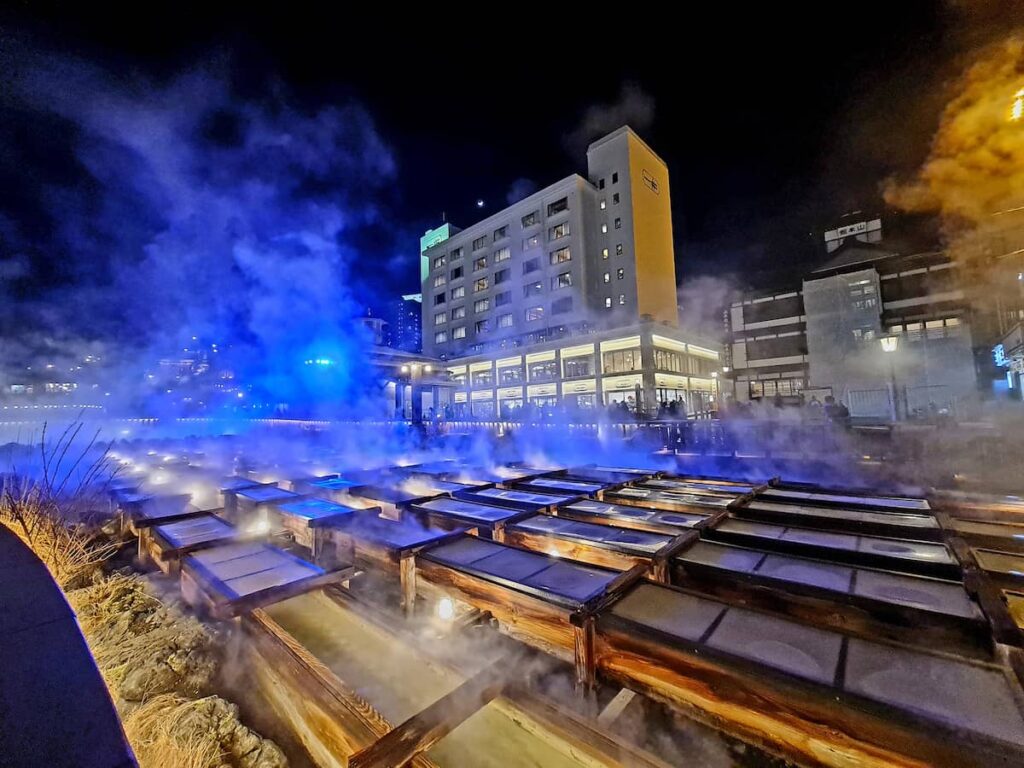

The collaboration of the lights and the hot water is not easy to see!
Recommended Eateries
- Tomoe-ya & Shateki Chaya
- Ishi-Usu Soba Mikuniya
- Kusatsu Onsen Pudding
Tomoe-ya & Shateki Chaya
One of the nostalgic activities you can enjoy in Kusatsu Onsen is playing retro games. The most popular options are smart ball and shooting galleries (shateki).
You can play smart ball only at Tomoe-ya. It’s a fun and old-fashioned game that brings back a sense of nostalgia.
There are three places where you can enjoy shateki:
- Tomoe-ya
- Shateki Chaya
- Shateki Honpo Mandarado (below Tomoe-ya)
However, I strongly do not recommend Shateki Honpo Mandarado. The staff’s attitude is quite poor, and they offer no helpful advice on how to play, which can ruin the experience.
Even if it’s crowded, I highly recommend choosing Tomoe-ya or Shateki Chaya for a more enjoyable and welcoming atmosphere. You’ll have a much better time there!
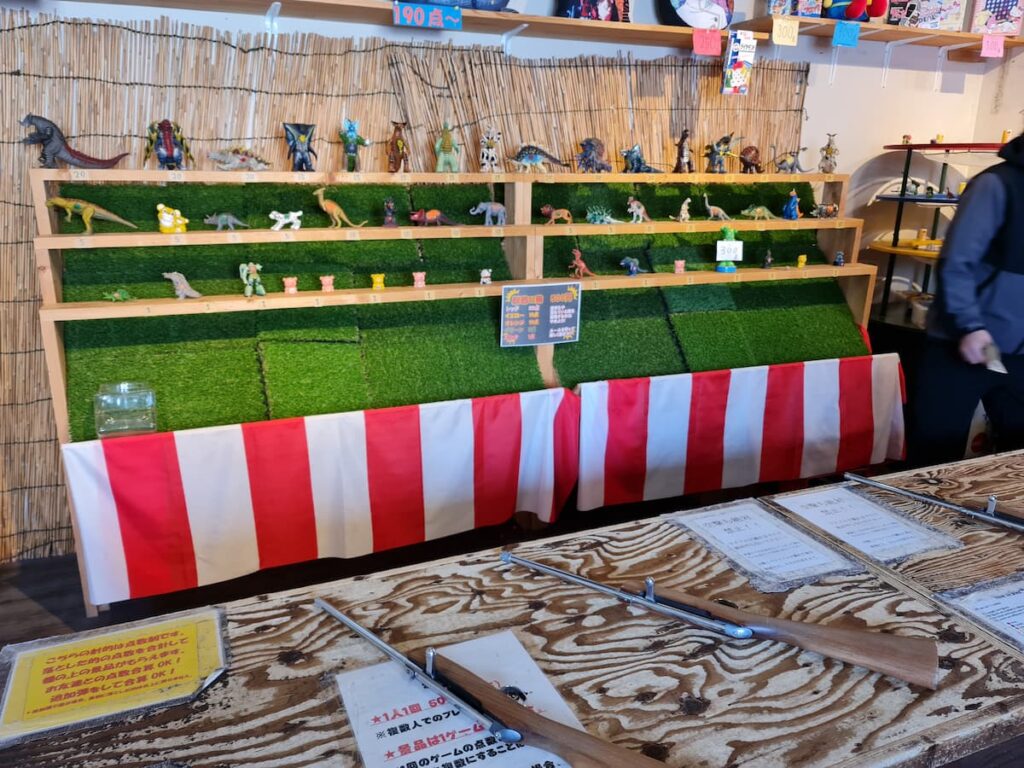
Ishi-Usu Soba Mikuniya
Next up is dining! One characteristic of Kusatsu Onsen’s dining scene is that almost every restaurant has long lines, both during the day and at night. Among them, Mikuniya stands out as a place where people form long queues even before opening, and it often sells out. I lined up 30 minutes before opening, but I was only able to get in 45 minutes after the doors opened.
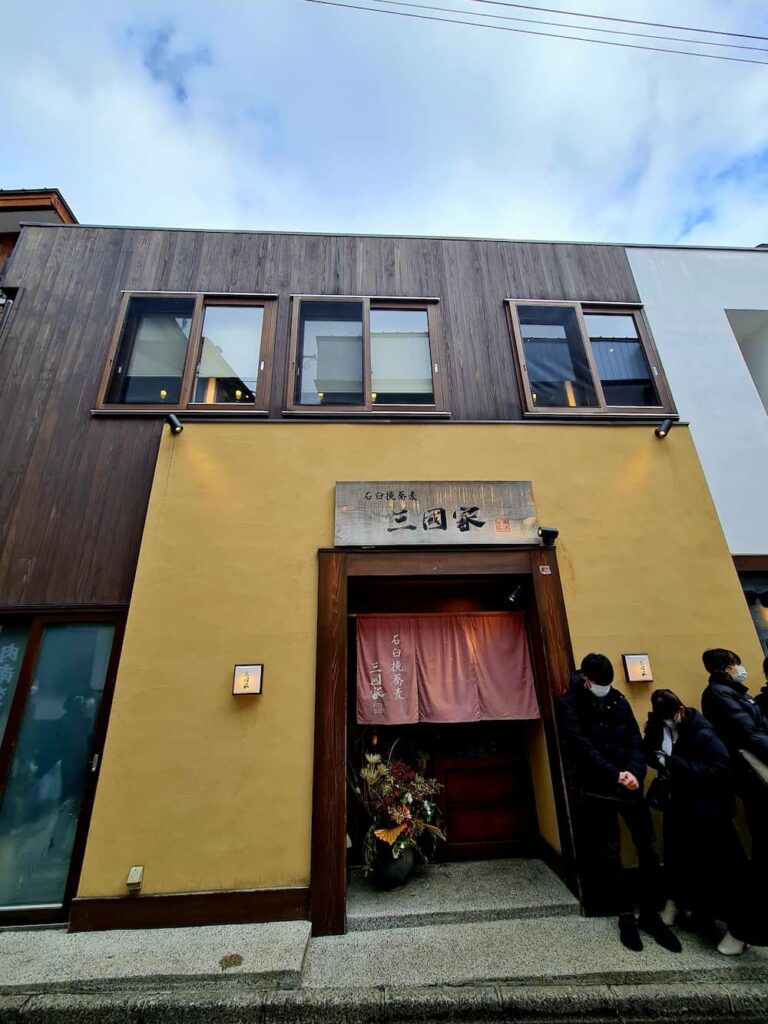
Their homemade soba, made from stone-milled flour ground on-site, is incredibly popular.
The noodles have a smooth texture and a firm, chewy bite, making them the perfect choice for those who love robust, satisfying soba.
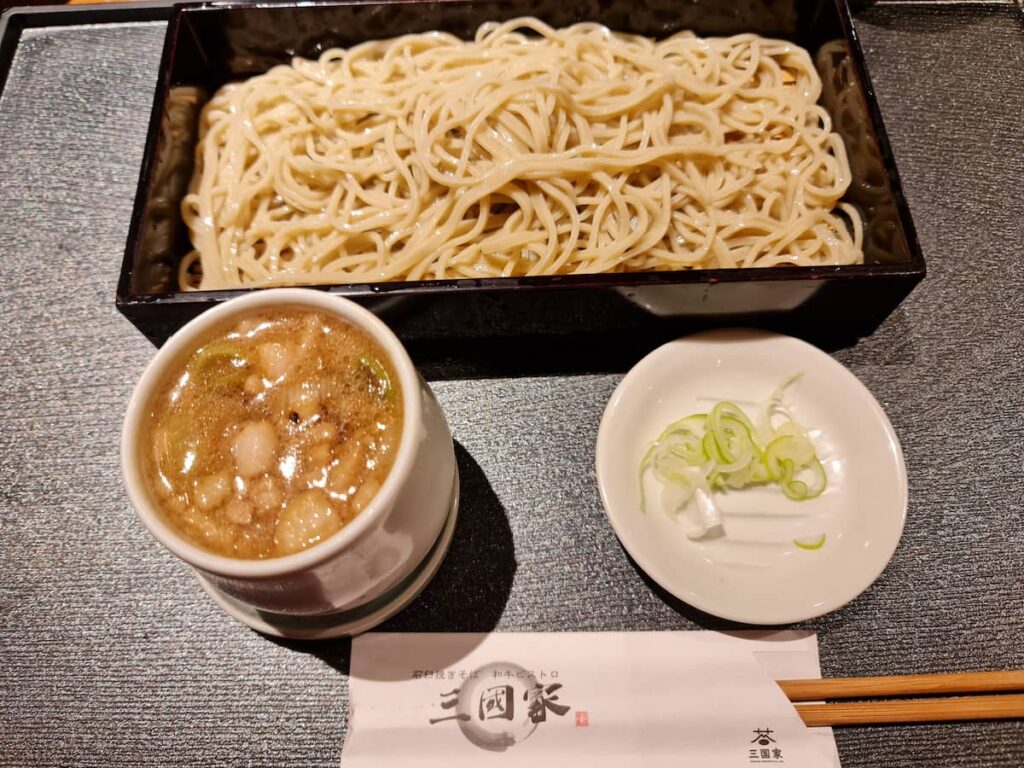
I ordered Mikuni soba with kizami kamo seiro.I regretted that I should have ordered a large portion.If you would like to see other menu items, please refer to the official website below.
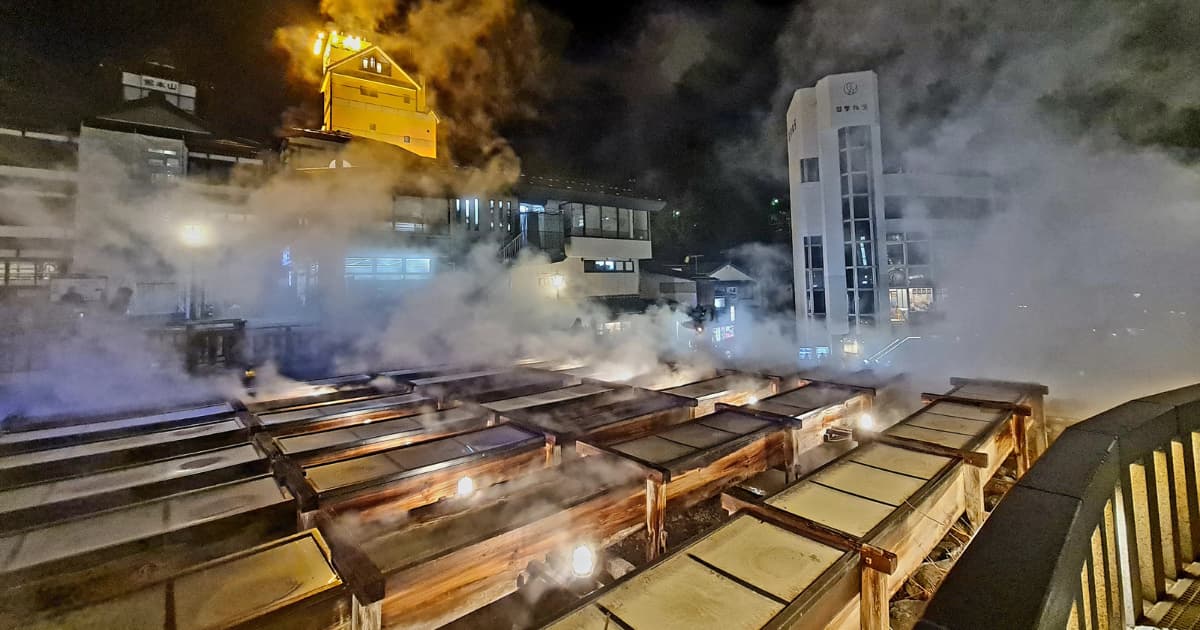
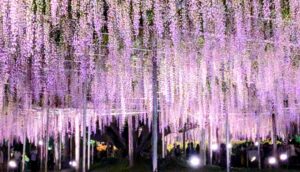
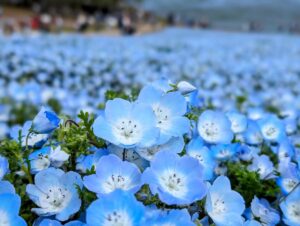
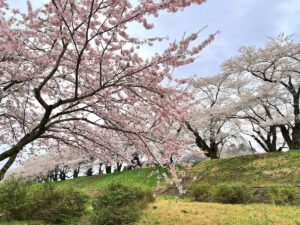

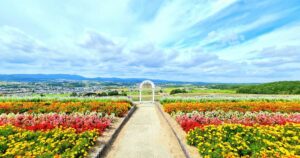
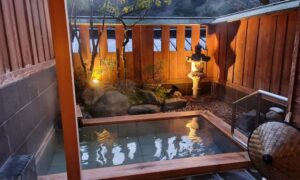
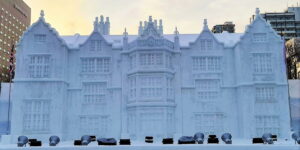
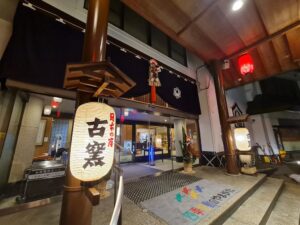
Comments